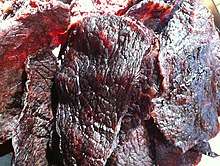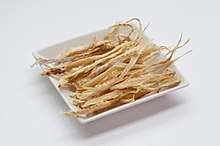Po (food)
Po (Korean: 포) is thin strips or sheets of dried meat and fish used in Korean cuisine.[1] Po, which is made from meats including beef, pork, venison and poultry; and seafoods including whitefish, eel, squid, octopus, shrimp and crab; is eaten as snack food, banchan (food accompanying bap) or anju (food accompanying sul).[1][2] Po is prepared for traditional occasions such as pyebaek (formal greetings from the newlyweds after the wedding ceremony) and jesa (ancestral rite).[3][4]
 | |
| Type | Dried meat or fish |
|---|---|
| Place of origin | Korea |
| Associated national cuisine | Korean cuisine |
| Similar dishes | Jerky |
| Korean name | |
| Hangul | 포 |
|---|---|
| Hanja | 脯 |
| Revised Romanization | po |
| McCune–Reischauer | p'o |
| IPA | [pʰo] |
Name
The Sino-Korean word po (포) can be written with the hanja 脯, which in other East Asian languages and cuisines can also mean preserved fruit.[5]
History
History of po is thought to date back to pre-historic hunter-gatherer societies.[3]
According to Samguk sagi (History of the Three Kingdoms), an 1145 book written by Gim Bu-sik, in February 683 the King Sinmun of Silla sent 135 carts of rice, wine, oil, honey, jang (soy sauce, soybean paste), vinegar, and po to Gim Heum-un's house for his daughter's wedding.[6]
Northern Song Chinese scholar Wu Ji (?–1142) described Goryeo Koreans seasoning nokpo (녹포, 鹿脯, dried venison) with cinnamon.[7]
In Joseon Korea, po made in governmental offices was called gwanpo (관포, 官脯, "governmental po").[8] Among them, large pyeonpo that was made in Bongsangsi (Office of Sacrificial Rites) for jehang (governmental jesa) was called jopo (조포, 造脯).[9] Geonpo used for jehyang was called jungpo (중포, 中脯).[10] At Korean New Year, it was common for provincial officials to send pochok (포촉, 脯燭, "po and candles") to their relatives and officials in the central government.[11] Extravagant banquets were referred to as yuk-san-po-rim (육산포림, 肉山脯林), literally meaning "po mountains, meat forests".[12] Beef po was also often used to make upo-dasik (우포다식, 牛脯茶食), a kind of dasik (tea food).[13] The 18th-century book Sasojeol (Elementary Matters of Etiquette for Scholar Families), which was written by the Joseon scholar Yi Deok-mu (1741–1793), states; "Do not frequently smell fish or seafood po{{{1}}}".[14] Cheolli-po (천리포, 千里脯, "thousand-ri po"), made from meats marinated for a day in wine, vinegar, and salt, was prepared for long journeys.[15] (1 ri is around 393 m (1,289 ft), and 1,000 ri is 393 km (244 mi).)
Varieties
Meat or fish that is thinly sliced and dried is usually called geonpo (건포, 乾脯), while meat that is pounded flat and dried is called pyeonpo (편포, 片脯). Dried meat in general can be referred to as poyuk (포육, 脯肉), with the letter yuk (육, 肉) meaning "meat", while the differently ordered compound yukpo 육포 肉脯) refers to dried beef slices.[1][2] Dried fish is called eopo (어포, 魚脯) with the letter eo 어 魚) meaning "fish".[1]
When the meat is seasoned with salt and pepper, it is called yeompo (염포, 鹽脯), while the dried meats seasoned or marinated with soy sauce-based seasonings are called jangpo (장포, 醬脯), pyeonpo (편포, 片脯), sanpo (산포, 散脯), or yakpo (약포, 藥脯), according to the methods.[16]
Meat
- Nokpo (녹포, 鹿脯) – venison
- Jangpo (장포, 獐脯) – Siberian roe deer venison
- Jeyuk-po (제육포) – pork, salted and dried, parboiled in diluted wine, and dried again
- Yukpo (육포, 肉脯) – beef
- By method
- Baepo (배포, 焙脯) – thinly sliced beef or pork, seasoned and dried on baerong (배롱, 焙籠) on fire
- Jangpo (장포, 醬脯) – seasoned with aged soy sauce, massaged, and dried
- Jangpo (장포, 醬脯) – thick slices of lean meat is repeatedly grilled to sear skin, beaten with bats, and seasoned with aged soy sauce, until thoroughly cooked
- Pyeonpo (편포, 片脯) – meat is pounded flat with knife, and dried
- Sanpo (산포, 散脯) – meat sliced into pieces and sun-dried
- Yakpo (약포, 藥脯) – meat is thinly sliced, seasoned with soy sauce, oil, sugar, and pepper, massaged, and dried on sokuri
Poultry
- Geowi-po (거위포) – goose
- Gireogi-po (기러기포) – wild goose
- Chiyuk-po (치육포, 雉肉脯) – pheasant
Seafood

- Chupo (추포, 秋脯) – squid
- Eopo (어포, 魚脯) – thinly sliced fish
- Gepo (게포) – fiddler crab meat
- Saengseon-po (생선포, 生鮮脯) – fish
- Saeu-po (새우포) – shrimp, halved, marinated, dried and grilled
- Pressed
- Jwipo (쥐포) – thread-sail filefish, dried and pressed
- Muneo-po (문어포, 文魚脯) – giant octopus, dried and pressed
- Ojingeo-po (오징어포) – squid, dried and pressed
Others
- Sapo (사포, 蛇脯) – snake meat, eaten as folk remedy in the past
Uses
Po made from various meats, fish, and seafood are eaten as snack food, banchan (food accompanying bap) or anju (food accompanying sul).[1][2] Salted and dried meat po are eaten as po-jaban (포자반), a salty banchan.[17] Crab and other seafood po are beaten, fluffled, seasoned with soy sauce and oil, and eaten as muchim.[18] Fish po are seasoned with soy sauce or gochujang and are grilled as gui.[19]
Po are one of the foods prepared for traditional occasions such as pyebaek (formal greetings from the newlyweds after the wedding ceremony) and jesa (ancestral rite).[3][4] Po and sikhye (rice punch) used for jesa is called pohye (포혜, 脯醯).[20] Often, po is put on the left side of the jesasang (table for ancestral rites) and sikhye is put on the right; this is referred to as jwa-po-u-hye (좌포우혜, 左脯右醯), literally meaning "left po, right sikhye".[21] Another related term is ju-gwa-po-hye (주과포혜, 酒果脯醯), literally meaning "wine, fruit, po, sikhye", which refers to simple offerings for jesa.[22]
See also
References
- Korean Food Guide 800. Seoul: The Korea Foundation. 2014. ISBN 978-89-89782-10-0. Retrieved 28 September 2018.
- Pettid, Michael J. (2008). Korean Cuisine: An Illustrated History. London: Reaktion Books. p. 61. ISBN 978-1-86189-348-2. Retrieved 28 September 2018.
- Park, Ji-Hyoung; Lee, Kyung-Hee (2005). "Quality Characteristics of Beef Jerky made with Beef meat of various Places of Origin". Korean Journal of Food and Cookery Science. 21 (4): 528–535. Retrieved 28 September 2018.
- Lee, Chang Hyeon; Kim, Young (2018). "Jongka, the traditional Korean family: Exploring jongka food in the context of Korean food categories". Journal of Ethnic Foods. 5 (1): 40–53. doi:10.1016/j.jef.2018.02.006.
- Pan, Junlin (2012). "6. Chinese Unconventional Characters: Characteristics, Controversial Arguments, and Pedagogical Implications". In Goodman, Ken; Wang, Shaomei; Iventosch, Mieko Shimizu; Goodman, Yetta (eds.). Reading in Asian languages: Making sense of written texts in Chinese, Japanese, and Korean. New York, NY: Routledge. ISBN 978-0-415-89476-0. Retrieved 15 October 2018.
- Ann, Yong-Geun; Woo, Nariyah (2012). "A Study on the Classified Jang(Fermented Soybean) in Goryeo and Chosun Dynasty Period". The Korean Journal of Food and Nutrition. 25 (3): 460–482. doi:10.9799/ksfan.2012.25.3.460. Retrieved 28 September 2018.
- Cho, Wookyoun (2011). "Spicy Taste of Korean Traditional Food". Journal of the Korean Society of Food Culture. 26 (4): 374–382. Retrieved 28 September 2018.
- "Gwanpo" 관포. Standard Korean Language Dictionary (in Korean). National Institute of Korean Language. Retrieved 28 September 2018.
- "Jopo" 조포. Standard Korean Language Dictionary (in Korean). National Institute of Korean Language. Retrieved 28 September 2018.
- "Jungpo" 중포. Standard Korean Language Dictionary (in Korean). National Institute of Korean Language. Retrieved 28 September 2018.
- "Pochok" 포촉. Standard Korean Language Dictionary (in Korean). National Institute of Korean Language. Retrieved 28 September 2018.
- "Yuk-san-po-rim" 육산포림. Standard Korean Language Dictionary (in Korean). National Institute of Korean Language. Retrieved 28 September 2018.
- Oh, Soon-Duk (2012). "A Literature Review of Dasik in the Joseon Dynasty Royal Palace". Journal of the Korean Society of Food Culture. 27 (3): 316–323. doi:10.7318/KJFC/2012.27.3.316. Retrieved 28 September 2018.
- Ju, Young Ae; Won, Miyeon (2016). "Consideration of the Courtesy Education at the Dining Table in the Books of Social Norms of Joseon Dynasty Era". Family and Environment Research. 54 (4): 415–426. doi:10.6115/fer.2016.032. Retrieved 28 September 2018.
- "Cheolli-po" 천리포. Standard Korean Language Dictionary (in Korean). National Institute of Korean Language. Retrieved 28 September 2018.
- "특별음식". 조선의 오늘 (in Korean). 평양모란봉편집사. 2 December 2014. Retrieved 28 September 2018.
- "Po-jaban" 포자반. Standard Korean Language Dictionary (in Korean). National Institute of Korean Language. Retrieved 28 September 2018.
- "Gepo-muchim" 게포무침. Standard Korean Language Dictionary (in Korean). National Institute of Korean Language. Retrieved 28 September 2018.
- "Baengeo-po-gui" 뱅어포구이. Standard Korean Language Dictionary (in Korean). National Institute of Korean Language. Retrieved 28 September 2018.
- "Pohye" 포혜. Standard Korean Language Dictionary (in Korean). National Institute of Korean Language. Retrieved 28 September 2018.
- "Jwa-po-u-hye" 좌포우혜. Standard Korean Language Dictionary (in Korean). National Institute of Korean Language. Retrieved 28 September 2018.
- "Ju-gwa-po-hye" 주과포혜. Standard Korean Language Dictionary (in Korean). National Institute of Korean Language. Retrieved 28 September 2018.